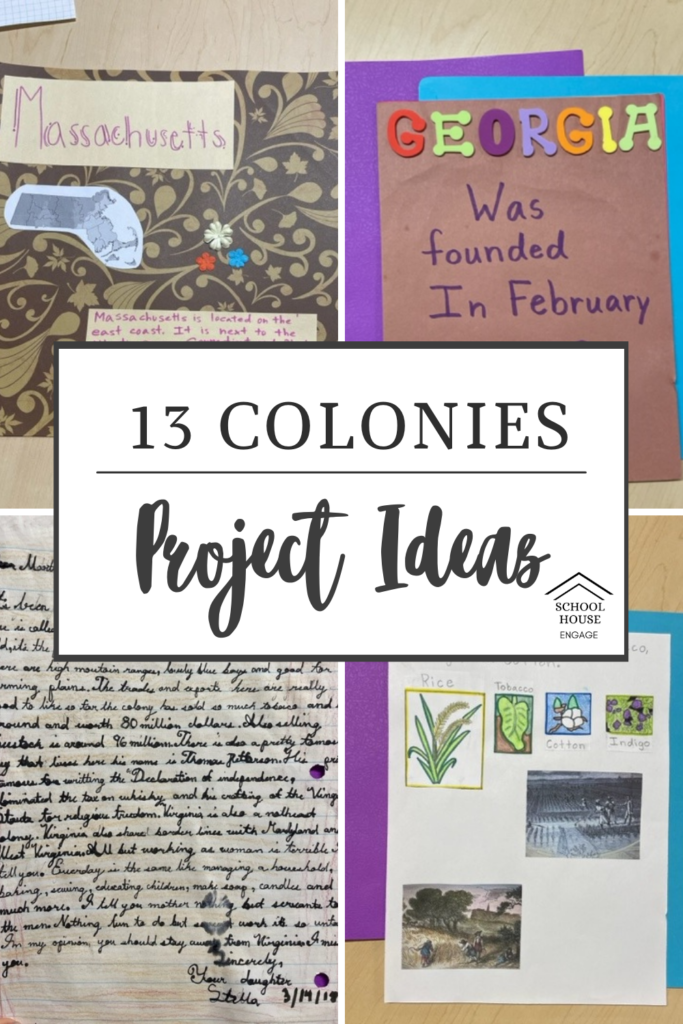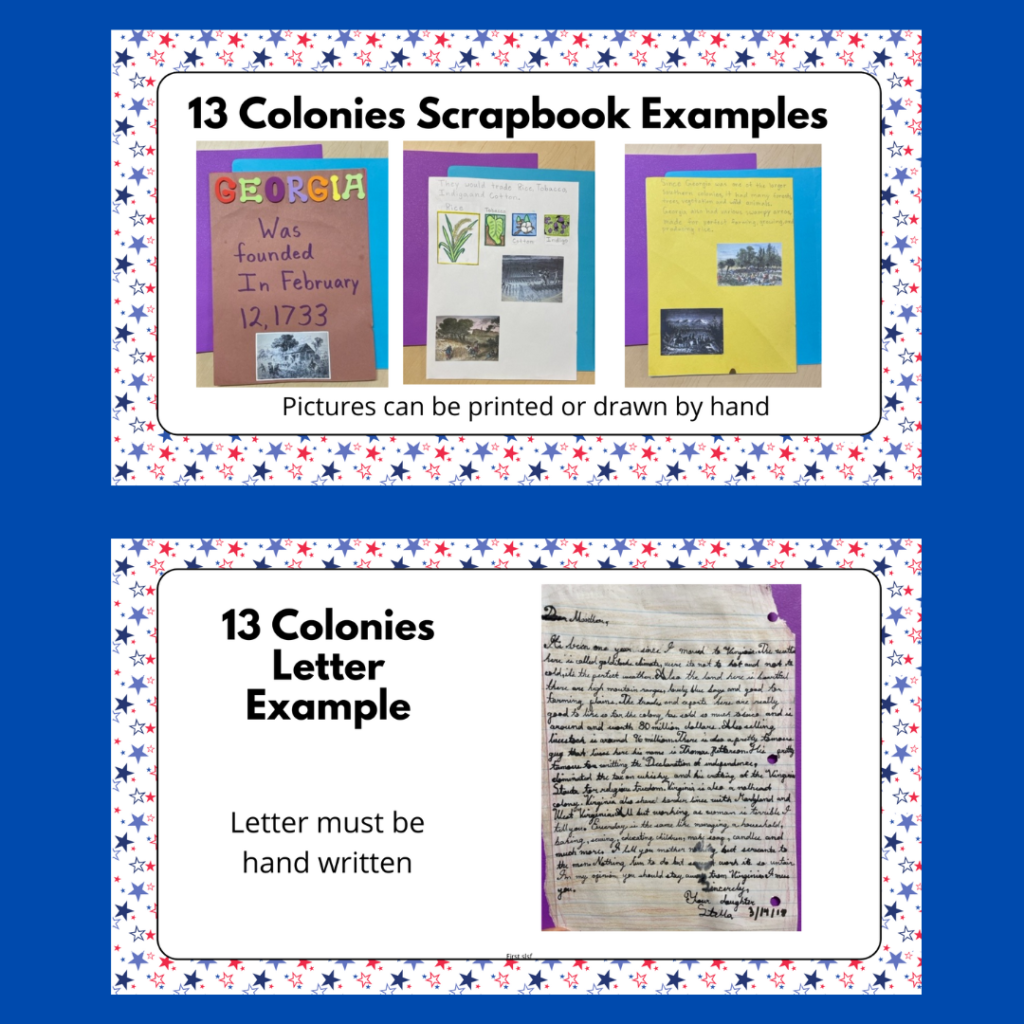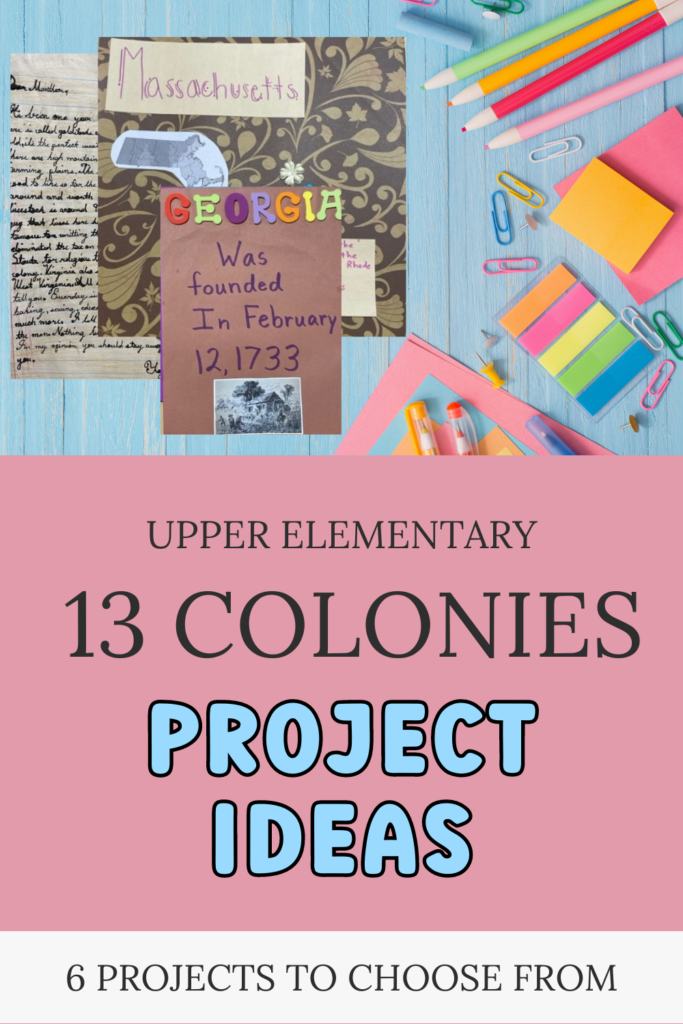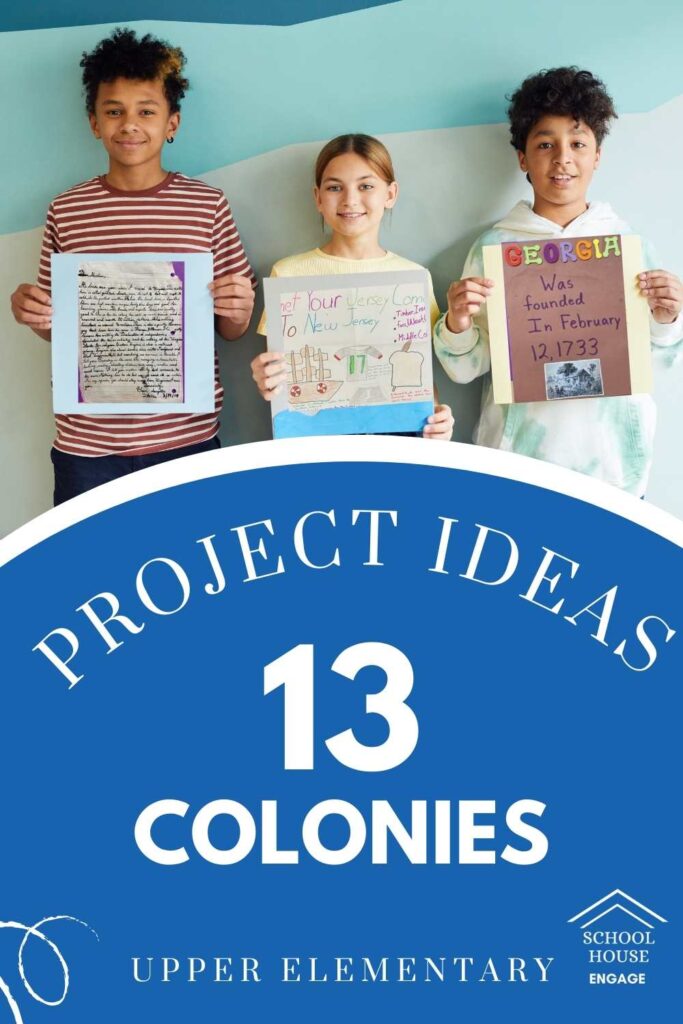The best way to keep students engaged and excited about completing 13 Colonies projects is through student choice. When students choose what project they want to complete, it inspires them to learn and to put forth more effort.
Engage Students with 13 Colonies Projects through Student Choice
After my students study the 13 Colonies, they complete a culminating project about the colony of their choice. I first present the list of all 6 projects to my students, either by printing it out or putting the digital version in Google Classroom.
In each project students are required to include the following information about their colony:
- Geography: Does the colony have a large lake or river? Are there mountains or valleys?
- Climate: What was the weather like in the winter and summer?
- Trade/Exports: What does the colony produce? What were the major exports during colonial times?
- Founder: What was the name of the person who founded the colony? Describe who that person was.
- Location of Colony: Is it part of the Northern, Middle, or Southern Colonies? What other colonies does it share a border with?

Project Options for 13 Colonies: Six Creative Choices
Letter
Students pretend to be a settler in a colony of their choice and write a letter to a friend or family member back in Europe describing the colony and their daily life.
Poster or Infographic
Students create a poster or go online and use a free graphic design website like Canva to describe the colony of their choice with images and bold, colorful text.
Scrapbook
Students pretend they took a trip to the colony of their choice. They create a scrapbook of their memories of visiting the colony. It will include drawings or pictures with captions, actual physical items, ticket stubs, and souvenirs.
Infomercial
Students promote their colony so that people will choose to live there. They must think of themselves as a colonial influencer who is talking on YouTube.
Presentation (Google Slides or PowerPoint)
Students create a presentation that will teach others about their colony. Each slide will have images and animations that describe the colony.
Poem
Students will teach others about their colony through poetry. It can persuade people to move there, or it can celebrate the different characteristics of the colony itself.
Showcasing Student Examples for 13 Colonies Projects
Students can feel overwhelmed when I tell them that they are completing a project. My overachiever students especially will feel stressed and will put a lot of pressure on themselves. To lower anxiety, I encourage you to always show students examples of projects.
How to Use Student Examples to Reduce Anxiety
Every year I save a few projects from students who give me permission to keep them. Sometimes I save exemplary projects or projects that are poor quality so that they can know what is expected.
What if this is your first time completing this project? You can head over to my Pinterest account where I have a few photos of students’ examples, or I created a Google Slides presentation with photos of each project . Click HERE to check it out.
I show the slides with photos of examples or actual examples that can be passed around before students make their decision on what project they want to complete.

Classroom Organization Tips for Different 13 Colonies Projects
Create a Student Project List
Once students decide on what project they want to do, pass around a “Student Project List”. You can create your own or click HERE to use the one I created. Students write their name and the name of the project they chose.
Then count how many students are doing which project. This allows you to know how many specific directions for each of them you need to print.
Managing Time: Classroom and Home Balance for Project Work
When students complete projects, they need sufficient time. I allow my students to work on the project for a few days during my Social Studies block to help them get started.
After the first day of assigning the project, I sent home a parent letter so they know the project needs to be done at home. I ask my parents to help their child by scheduling time for them to work on their project.

Support students while they complete their 13 colonies project
During the first few days when students are working on their projects in the classroom, it’s important to call up students who chose the same project and meet with them in a small group. Go over the rubric so they know what is expected, and answer any questions they may have.
I know it’s tempting to grade papers or check email when students are working independently but make time to walk around to make sure that students are completing the project correctly.
Effective Small Group Meetings During Project Work
On subsequent days, call up the same groups and ask where they are in their project. This holds students accountable. I ask to see what they have accomplished so far and I assist them with ideas.
Tips for Monitoring Student Progress and Providing Feedback
Provide students with rubrics so that they know exactly what is expected on the first day and revisit these rubrics during small groups. You will need to refer back to your student list so you know how many of each rubric to print. Make sure they return the rubrics to you along with their project on the day they are due.
Showcase and Assess 13 Colonies Projects with a Gallery Walk
Conducting a Successful Gallery Walk for 13 Colonies Projects
When all projects are turned in, I allow for a “galley walk” so that students can walk around and see what others have done. I play a song, and within that time, students walk around and look at students’ projects that are placed on tables or desks. When the song finishes, they have to sit back down.
No talking is allowed! I do this to discourage students from voicing their opinions about other projects and just to maintain order. If a student is talking, they have to sit down. Make sure to follow through!
If students have a Google Slides presentation, I ask my students to leave their laptops open and set their presentation to Slideshow mode.
Grading 13 Colonies Projects Efficiently with Rubrics
The final step is to collect projects to grade using rubrics that they return with their project. Make sure to print some extras because there are always a few students who lose them. You know how it is! Rubrics are easy to use and will make grading a breeze.

I hope I’ve given you some ideas on the different types of projects your students can complete when they are done learning about the 13 colonies.
I have everything you need for your students to complete their 13 colonies projects. It includes editable student directions, rubrics, student examples, a parent letter, a helpful links page, and much more.
If memorizing the 13 colonies is a requirement in your classroom , you will want to download my free 13 Colonies Actonym freebie sheet below.
You got this! Giselle
Save this for later. Click on the image and save it to your teacher’s Pinterest board. 📌📌📌

You may also want to read:
Time-Saving Lesson Plans to Teach the 13 Colonies
The Easy Way to Teach Your Students the Names of the 13 Colonies
